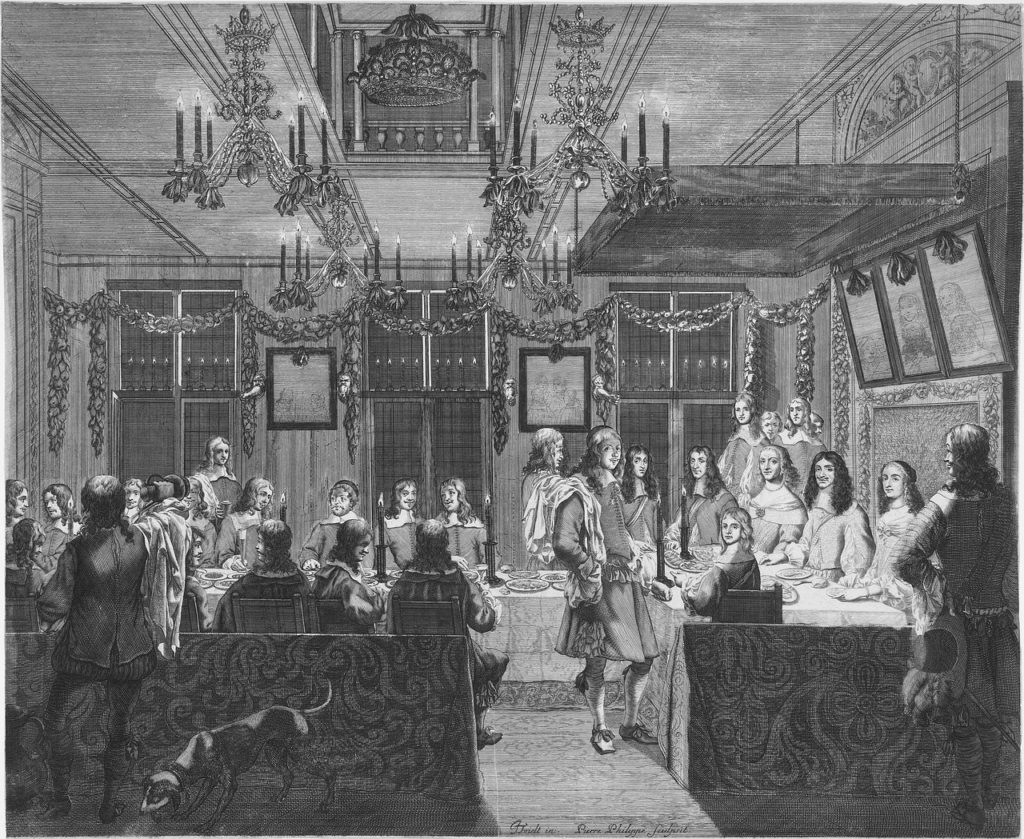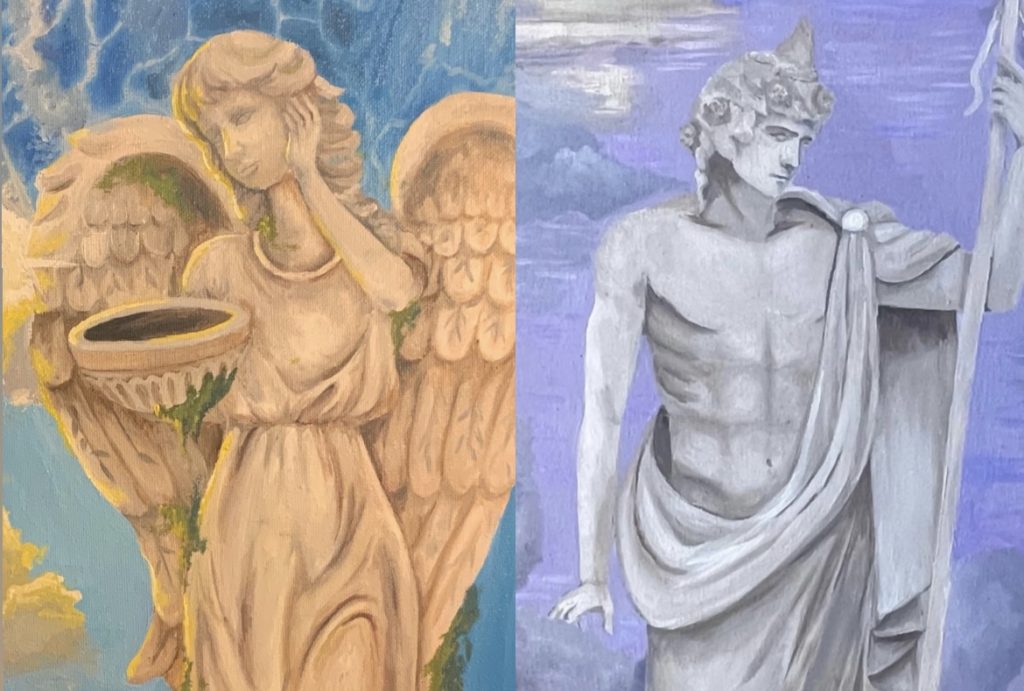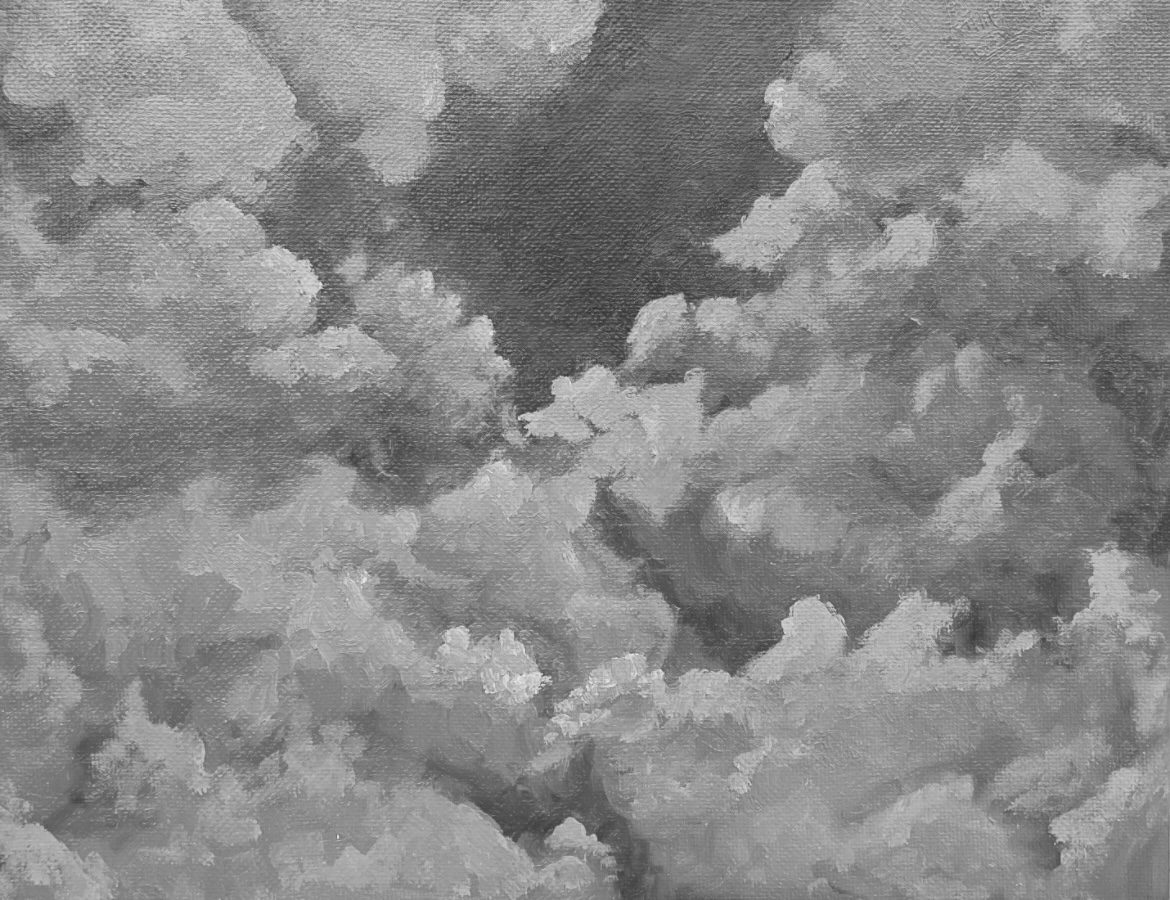The grisaille method is part of painting that even if you dont use, you should know. In this post, I am going to explain the history of the grisaille method and what you can learn from it to make your artwork even better.
When I first started oil painting, I didnt even know what underpainting was. I went my whole acrylic painting career without using underpainting either. When I saw someone on tiktok using an underpainting and then going over it, it was like my brain exploded.
It’s so genius! You know exactly what you want your painting to look like, and then add the color. It give you so much more time to also contemplate the color palettes, which is a problem I have. Im relatively bad at picking out palettes without color theory involved, so its very helpful to have it all in black and white first and see where color would even look good.
Also, and I think my favorite thing, is that it makes me focus on the work itself. I am not just relying on the colors to do the work for me. It makes yo really think more about what it is that you’re making, and makes you find so much more detail in the process.
First, there are three important forms of underpainting that I want to highlight. The Verdaccio, imprimatura, and the Grisaille. All have different goals and slightly different outcomes, depending on how you use them. They can bring a different energy or vibe to ever piece of artwork you create, and can help you create your signature style.
An underpainting is the first layer traditionally painted on a canvas when an artist is beginning their piece. In most cases, it can really enhance the artist’s vision and comprehension of their work. It adds the first set of dimension to the canvas and allows the viewer/artist’s eyes to decipher the different values that will be in the picture.
I personally prefer grisaille for acrylic paintings, but it can be a great tool for glazing methods with oil paint.
What is the Grisaille method?
It is a style of underpainting that uses grey tones to allow the artist to focus on only the values and contrast of their painting. Gris in grisaille translates from French to grey.
- Establishing Values: By working in shades of gray, artists focus on capturing the range between light and dark values in a painting. This allows them to concentrate on form, light, and shadow without the added complexity of color.
- Form and Structure: Grisaille helps define the forms and shapes within the composition. It aids in creating a strong foundation, outlining the basic structure of the painting.
- Depth and Dimension: By skillfully manipulating tonal values, artists create depth and three-dimensionality in their paintings, emphasizing volume and space.
- Preparation for Color Layers: Once the Grisaille underpainting is complete and dry, artists can apply transparent or semi-transparent layers of color (glazes) over the grayscale foundation. This method of layering colors enhances the depth and richness of the final artwork.
- Historical and Contemporary Use: Grisaille has a historical background, commonly associated with traditional European painting techniques. However, contemporary artists also use this method as a foundational step in their painting process.
The history of grisaille
While its exact birthplace might not be pinpointed to a single location, the Grisaille technique became a fundamental part of European painting traditions. It plays a significant role in the development of various artistic movements. Its use extended beyond Europe and was embraced in art practices across different cultures and periods. Grisaille serves as a foundational approach for creating depth, form, and tonal accuracy in paintings.
The Grisaille method of underpainting has a long history and is often associated with traditional European painting techniques, particularly those used during the Renaissance and Baroque periods. Its origins can be traced back to these artistic eras in Europe, notably Italy and the Low Countries.
During the Renaissance, artists such as Leonardo da Vinci, Jan van Eyck, and other masters utilized the Grisaille technique as a foundational method in their paintings. This approach was particularly evident in their preparatory studies, sketches, and in the initial stages of creating artwork. It is associated as a “starting” faze of artwork, without the distraction of any color to confuse yourself when beginning the creative process.
It separates the value from the color
With the Grisaille method underneath the actual color, mixing paints can become much easier when you are able to focus on only the value of the color you are mixing.
You are able to place the color on the canvas and see how the value matches with your desired look from the underpainting. Whereas without the grisaille underpainting, you have to mix the color and try to create a value that will be accurate from only reference.

Why is grisaille important compared to other underpainting techniques?
Understanding the Grisaille method of underpainting holds significance compared to other underpainting techniques due to several reasons:
- Focus on Values and Form: Grisaille, with its monochromatic approach, emphasizes values (lights and darks) and form without the distraction of color. This allows artists to concentrate solely on tonal relationships and form, establishing a strong foundation for the painting.
- Historical Significance: Grisaille has a rich historical background, especially in classical European art. Learning this technique provides insights into traditional painting methods used by renowned artists from the Renaissance and Baroque periods, offering a link to art history and classical techniques.
- Preparation for Glazing and Color: As a base layer, the Grisaille method prepares the canvas for subsequent layers of transparent or semi-transparent color (glazes). The grayscale underpainting ensures a well-defined structure, allowing the artist to build colors on a solid foundation.
- Teaches Tonal Relationships: Understanding Grisaille aids in comprehending the relationship between light and shadow. It allows artists to learn how to render volume, depth, and three-dimensionality through the manipulation of tonal values.
- Versatility: While Grisaille is typically gray, it can also incorporate warm or cool grays, lending versatility to the technique. This adaptability allows artists to establish different moods and tones within their artwork.
Grisaille is a foundational method
Grisaille separates any use of color from the painting. Other methods lean towards certain colors which can affect the eye’s perception of colors when painting the next layer of color. For example, a blue underpainting can make greens look less yellow, purples less red, etc.
Grisaille paintings are often used for glazing techniques in oil painting as well.
It also covers the canvas from having the traditional stark white background that many artists like to avoid. This is because missing paint on a very small spot on the canvas will be much less noticeable than if the canvas was bright white underneath.

What is the best color for underpainting?
It is typically done with just white and black paints to create the truest form of contrast. I would recommend grisaille for acrylic paints. However, it is also known to be done with burnt siennas and brown tones for a warmer effect. That would more closely pertain to an Imprimatura underpainting. See difference in image below:

When you start to add color or saturation to your underpainting, here’s what you should know:
When adding saturation to a painting, the color you choose to introduce saturation will depend on the specific effect you want to achieve. Here are a few considerations:
- Complementary Colors: Introducing a complementary color to the dominant color in your painting can increase saturation. For example, adding a touch of red to a predominantly green area, or yellow to a mostly purple area. It can increase vibrancy and saturation due to the contrast between complementary hues.
- Primary Colors: Utilizing primary colors (red, blue, and yellow) can effectively increase saturation. Their purity and strength can boost the overall intensity of the painting. For instance, if you’re working with a blue-dominated area. Adding a pure, bright yellow could enhance the saturation due to their contrast.
- Warm vs. Cool Colors: Introducing warm colors (like reds, oranges, and yellows) can often increase perceived saturation due to their vibrancy. However, cool colors (such as blues and greens) can also add saturation, particularly when applied in pure, intense forms.
- Transparent and Intense Pigments: Consider using transparent and highly saturated pigments. Some pigments inherently possess greater saturation levels. For example, cadmium red, phthalo blue, or quinacridone magenta. These can significantly increase the saturation of the colors they are applied over.
- Layering with Glazes: Applying transparent or semi-transparent glazes of high-intensity color over the existing layers can intensify saturation. This method allows you to build up the vibrancy gradually without overwhelming the existing tones.
Remember, moderation is key when increasing saturation. It’s usually best to start with a small amount of the more intense or contrasting color and gradually build up. This way, you can gauge the impact on the overall color scheme and make adjustments as needed to achieve the desired level of saturation.
Here is how I typically start to add color to my pieces with Grisaille as the underpainting style:
It’s important to use only primaries. I like to start with as warm as you can get: reds. Add the rosy-ness back into the painting first. It’s a lot easier to see where the yellow hues, green hues, and blues need to be added. For some reason, it just brings life back to the piece in my opinion.
Whenever I start with blue or yellows, I feel like it is too bland of a piece. Then I tend to use too much of it. If I start with reds and pinks, I always can much better perceive where touches of each color are needed.
Why you need to be patient and wait for your underpainting to dry:
The process of the Grisaille underpainting typically involves allowing each layer to dry before applying subsequent layers. It’s generally recommended to let the underpainting completely dry before adding further layers, including the subsequent stages of color or additional detail work.
Here’s why allowing the underpainting to dry is advisable:
- Prevents Smudging: Allowing the underpainting to dry before proceeding prevents the risk of smudging or muddying the layers. Wet paint can be easily disturbed or mixed unintentionally when adding new layers on top.
- Maintains Clarity and Structure: A completely dried underpainting provides a stable and clear foundation for the subsequent layers. It allows you to build upon a solid base, ensuring that the tonal values, forms, and structures established in the underpainting remain intact.
- Better Control and Layering: Drying between layers allows for better control and precision in applying subsequent colors or glazes. This helps in maintaining the tonal relationships established in the underpainting while gradually building up the complexity of the artwork.
- Prevents Muddiness: If the underpainting is still wet when applying subsequent layers, there is a risk of colors blending unintentionally, potentially leading to a muddy or less defined appearance.
Therefore, it’s generally recommended to let each layer, including the Grisaille underpainting, thoroughly dry before progressing to the next stage. This approach helps maintain the integrity of the work and enables a more controlled and deliberate layering process.
What is open grisaille?
It is the first application of paint on a white panel or canvas, so youre only adding darker greys because you have the white base to start with. Basically, when there is nothing else there to start with.


Comments are closed.